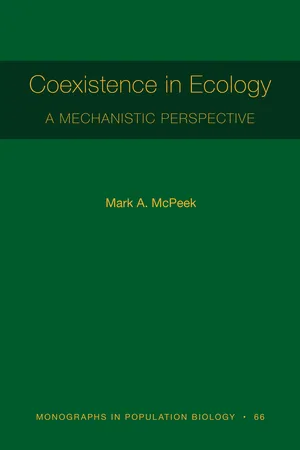
- 392 pages
- English
- PDF
- Available on iOS & Android
About this book
A comprehensive framework for understanding species coexistence
Coexistence is the central concept in community ecology, but an understanding of this concept requires that we study the actual mechanisms of species interactions. Coexistence in Ecology examines the major features of these mechanisms for species that coexist at different positions in complex food webs, and derives empirical tests from model predictions.
Exploring the various challenges species face, Mark McPeek systematically builds a model food web, beginning with an ecosystem devoid of life and then adding one species at a time. With the introduction of each new species, he evaluates the properties it must possess to invade a community and quantifies the changes in the abundances of other species that result from a successful invasion. McPeek continues this process until he achieves a multitrophic level food web with many species coexisting at each trophic level, from omnivores, mutualists, and pathogens to herbivores, carnivores, and basic plants. He then describes the observational and experimental empirical studies that can test the theoretical predictions resulting from the model analyses.
Synthesizing decades of theoretical research in community ecology, Coexistence in Ecology offers new perspectives on how to develop an empirical program of study rooted in the natural histories of species and the mechanisms by which they actually interact with one another.
Frequently asked questions
- Essential is ideal for learners and professionals who enjoy exploring a wide range of subjects. Access the Essential Library with 800,000+ trusted titles and best-sellers across business, personal growth, and the humanities. Includes unlimited reading time and Standard Read Aloud voice.
- Complete: Perfect for advanced learners and researchers needing full, unrestricted access. Unlock 1.4M+ books across hundreds of subjects, including academic and specialized titles. The Complete Plan also includes advanced features like Premium Read Aloud and Research Assistant.
Please note we cannot support devices running on iOS 13 and Android 7 or earlier. Learn more about using the app.
Information
Table of contents
- Cover
- Contents
- Acknowledgments
- 1. Introduction
- 2. Historical Antecedents
- 3. Building a Two-Trophic-Level Food Web
- 4. Adding a Third (and a Fourth and a Fifth . . .) Trophic Level
- 5. Omnivory in a Food Web
- 6. Mutualists, Symbionts, and Facilitators in a Food Web
- 7. Pathogens in a Food Web
- 8. Temporal Variability
- 9. Spatial Variability on Local and Regional Scales
- 10. Ecologically Equivalent and Neutral Species Embedded in a Food Web
- 11. MacArthur’s Recasting Revisited
- 12. Philosophical and Practical Implications
- Literature Cited
- Index